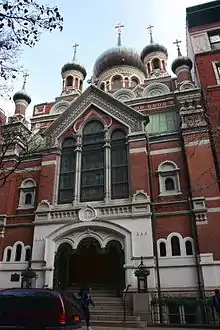St. Nicholas Russian Orthodox Cathedral (Manhattan)
St. Nicholas Russian Orthodox Cathedral (Николаевский собор РПЦ в Нью-Йорке) is located in the Upper East Side of Manhattan, New York City.

History
St. Nicholas Russian Orthodox Cathedral was built in 1901-02 from the designs of John Bergesen, a New York City architect of Russian origin. Its style is derived from Baroque architecture as it had evolved in Moscow. The construction in New York City of a traditional Russian church provided local parishioners with a familiar and reassuring place of worship.
The St. Nicholas congregation, which was established in 1894, met in a rented house at 323 Second Avenue until a permanent building could be erected. The purchase of the 75 by 100 foot lot, on ivhich the present church buildings stand, was undertaken by Dean Alexander Hotovitsky on behalf of the congregation in September 1899. The lot was smaller than what had initially been sought, and it was not a corner site, but the high cost of r eal estate in New York limited the selection. The New York City congregation was unable to .fully finance the building, so the Synod of Russia was given Imperial permission to collect money throughout the Russian Empire.
The ceremony of laying the cornerstone took place on May 22, 1901 , the day of the Feast of Translation, commemorating the transfer of the relics of St . Nicholas from Myra in Lycia, Asia Minor, to Bari, Italy in 1087. On November 23, 1902, a consecration service, the first to be held in the completed church, was led by Bishop Tikhon, the head of the Russian Church in the Aleutian Islands and North America. Bishop Charles Chapman Grafton, representing the Episcopal Church, participated in the service. The Russian Holy Synod elevated St. Nicholas Church to Cathedral status in December 1903, and the Diocesan Seat of North America was transferred from San Francisco to Ne1v York in 1905. Restoration work was carried out on the Cathedral between 1954 and 1960. Today St. Nicholas Cathedral continues to serve the needs of the Russian Orthodox Church in this country as it has since its founding.
Control over the use of this cathedral has been the subject of much litigation, twice reaching the United States Supreme Court. Kedroff v. St. Nicholas Cathedral (1952) 344 U.S. 94; Kreshik v. St. Nicholas Cathedral (1960) 363 U.S. 190.
The sanctuary of the Cathedral seats 900 people. A hall for a school and for meetings, space for a printing press, storerooms, quarters for a superintendent, and service facilities were provided in the basement.
A three-story rectory, immediately to the west of the church, is an integral part of the architectural composition. The round-arched entrance, surrounded by bead-and-reel and rope moldings, is surmounted by a low triangular pediment decorated with a shell motif. At the second floor three arched window openings are separated by paired colonnettes. Within each opening are a pair of pendant arches. The third floor windows are crowned by pedimented dormers projecting from the sloping roof. A terra-cotta band, continued from the church, accents the base of the roof.
The colorful elements of the composition are architecturally unified into a rich and exuberant example of Russian Baroque architecture. St. Nicholas Cathedral is important both for its architectural design and for the role played in the City's history by the Russian Orthodox Church in North America.